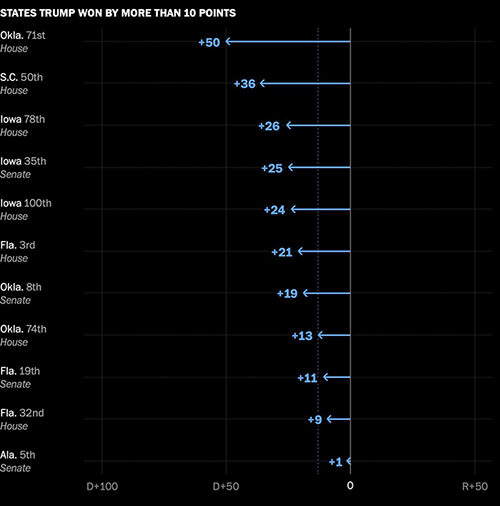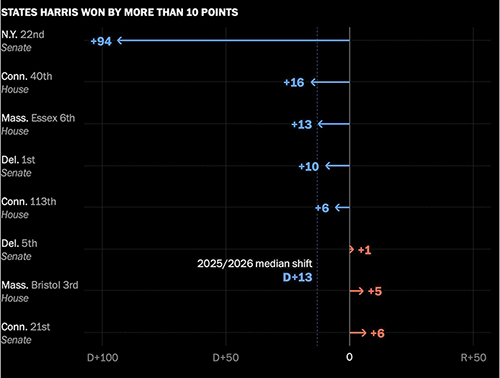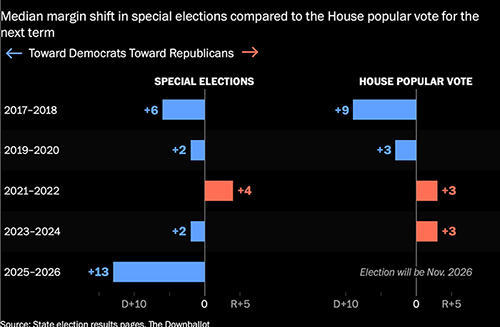

Special elections are, well, special. Nevertheless, people often try to read more significance into them than they are worth at face value. But are they actually worth anything? Fortunately, there are years of data in which special elections can be compared to subsequent congressional elections. A couple of young reporters gave it a shot.
To start with, history does tell us that the president's party very often gets whacked hard in the midterms. The conventional wisdom is that the opposition is ginned up and eager to take on the president's party while supporters of the president are despondent that he didn't do most of the things he promised. For example, presidents always promise to reduce the cost of living and they never do.
So far, since Jan. 20, 2025, there have been 31 special elections at various levels. In 27 of them, there has been movement toward the Democrats compared to the 2024 elections. This could be due to who turns out for wonky special elections, but even that could be an indicator of energy and enthusiasm. It could also be an indicator that 2024 was abnormal, with marginal voters who turned out specifically for Donald Trump, but didn't bother turning up in state Senate races and probably won't show up for House elections in 2026 either, since Trump won't be on the ballot.
Let's start with state legislative races, in three batches: very red states, closer states, then very blue states. Here are the results for special state legislative elections in red states that Donald Trump won by more than 10 points. A blue arrow going to the left indicates that the Democrat in the special election did better than Kamala Harris did in 2024. A red arrow to the right indicates that the Democrat in the special election did worse than Harris.

In the Trumpy states, every Democrat running in a special election for the state legislature did better than Harris. This could be a sign that the marginal Trump voters who showed up for him in 2024 have lost their interest in voting, but who knows?
Now on to closer states. These special elections for state legislative seats that took place in states where the presidential winner's margin was 10 points or fewer. They are swingier than the ones above and below, but not all are truly swingy:

Same pattern as in the very red states except in one New Hampshire state House race, the Democrat did 1 point worse than Harris in 2024. Basically, the same conclusion.
Now we have the results for special elections for the state legislature in states that Kamala Harris won by more than 10 points.

As you can see, the 22nd state Senate district in New York moved 94 points toward the Democrats in the special election. Huh? This district has a very large number of Orthodox Jews who vote as a bloc based on what their rabbis tell them. This gives them more power than if everyone voted his or her personal preference. They voted in large numbers for Trump because their rabbis didn't trust Harris on Israel. In state elections, they normally vote for Democrats, and that shows up here.
Finally we have two special elections for the U.S. House. Both races were in Florida and both races went for the Republicans. Nevertheless, the Democrats in the special congressional elections did much better than Harris did in 2024.

Now the $64,000 question is: Does any of this have predictive value for the 2026 midterms? Answer, based on historical data: yes. With some homework, one can look at special elections in 2017-2018 and compare them to the 2018 House popular vote. Likewise, the 2019-2020 special elections can be compared to the 2020 House popular vote, and so on. Here are the data:

So, what can we learn? In 2018, 2020, and 2022, the special elections were a good predictor of the popular vote in the next House election. In 2024, they were not. Of course, the 2024 elections were unusual with Joe Biden dropping out in July and Donald Trump bringing large numbers of marginal voters and minorities who are normally Democratic. Still, given the immense swing toward the Democrats in this year's special elections (D+13, on average) and the increasing unpopularity of the Republicans, the Democrats have reason for optimism in 2026.
There is another indicator that has a decent (70%) prediction rate but it is too early to know: the Virginia gubernatorial election. When a Democrat is elected as governor of Virginia, the Democrats usually do well in the House the next year. We'll get that indicator in November. Nevertheless, we do have polls of the Virginia gubernatorial race. A May 12-19 poll from Roanoke College has Rep. Abigail Spanberger (D-VA) ahead of Lt. Gov. Winsome Earle-Sears 43% to 26% with the rest undecided. That is a 17-point margin. Another poll, by an unknown Republican pollster, has Spanberger ahead by only 4 points, 52% to 48%. We are automatically suspicious of a poll where 100% of the voters have an opinion already, especially since the Roanoke poll says 31% haven't made up their minds yet.
Also, Spanberger's approval/disapproval is at 41%/40% while Earle-Sears' is at 32%/48%. These data points suggest that Spanberger is ahead and, assuming she doesn't blow it somehow in the next 5 months, she is the favorite. That will be another hint about 2026. (V)